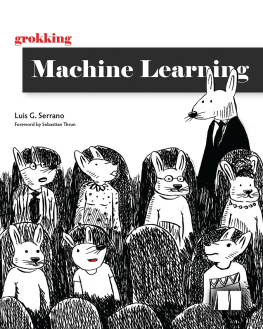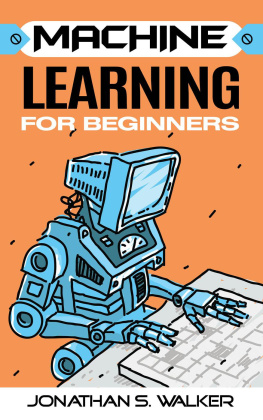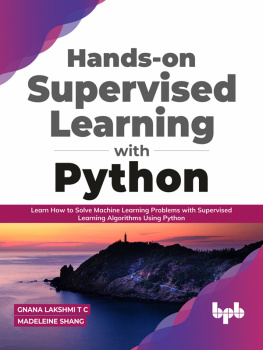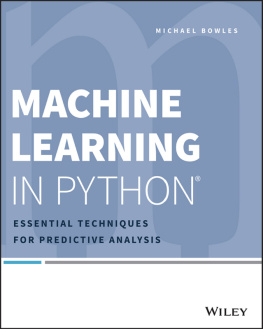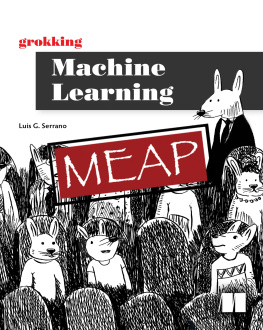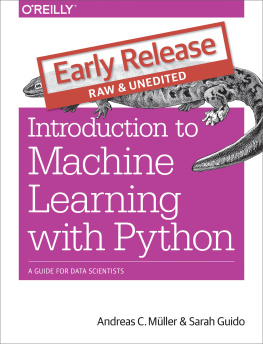inside front cover

The way to descend from the mountain is to take that one small step in the direction that makes us descend the most and to continue doing this for a long time.

Grokking Machine Learning
Luis G. Serrano
To comment go to liveBook

Manning
Shelter Island
For more information on this and other Manning titles go to
www.manning.com
Copyright
For online information and ordering of these and other Manning books, please visit www.manning.com. The publisher offers discounts on these books when ordered in quantity.
For more information, please contact
Special Sales Department
Manning Publications Co.
20 Baldwin Road
PO Box 761
Shelter Island, NY 11964
Email: orders@manning.com
2021 by Manning Publications Co. All rights reserved.
No part of this publication may be reproduced, stored in a retrieval system, or transmitted, in any form or by means electronic, mechanical, photocopying, or otherwise, without prior written permission of the publisher.
Many of the designations used by manufacturers and sellers to distinguish their products are claimed as trademarks. Where those designations appear in the book, and Manning Publications was aware of a trademark claim, the designations have been printed in initial caps or all caps.
Recognizing the importance of preserving what has been written, it is Mannings policy to have the books we publish printed on acid-free paper, and we exert our best efforts to that end. Recognizing also our responsibility to conserve the resources of our planet, Manning books are printed on paper that is at least 15 percent recycled and processed without the use of elemental chlorine.

| Manning Publications Co. 20 Baldwin Road Technical PO Box 761 Shelter Island, NY 11964 |
Development editor: | Marina Michaels |
Technical development editor: | Kris Athi |
Review editor: | Aleksander Dragosavljevi |
Production editor: | Keri Hales |
Copy editor: | Pamela Hunt |
Proofreader: | Jason Everett |
Technical proofreaders: | Karsten Strbk, Shirley Yap |
Typesetter: | Dennis Dalinnik |
Cover designer: | Leslie Haimes |
ISBN: 9781617295911
front matter
foreword
Did you think machine learning is complicated and hard to master? Its not! Read this book!
Luis Serrano is a wizard when it comes to explaining things in plain English. I met him first when he taught machine learning on Udacity. He made our students feel that all of machine learning is as simple as adding or subtracting numbers. And most of all, he made the material fun. The videos he produced for Udacity were incredibly engaging and remain among the most liked content offered on the platform.
This book is better! Even the most fearful will enjoy the material presented herein, as Serrano demystifies some of the best-held secrets of the machine learning society. He takes you step by step through each of the critical algorithms and techniques in the field. You can become a machine learning aficionado even if you dislike math. Serrano minimizes the mathematical kauderwelsch that so many of us hard-core academics have come to love, and instead relies on intuition and practical explanations.
The true goal of this book is to empower you to master these methods yourself. So the book is full of fun exercises, in which you get to try out those mystical (and now demystified) techniques yourself. Would you rather gorge on the latest Netflix TV show, or spend your time applying machine learning to problems in computer vision and natural language understanding? If the latter, this book is for you. I cant express how much fun it is to play with the latest in machine learning, and see your computer do magic under your supervision.
And since machine learning is just about the hottest technology to emerge in the past few years, you will now be able to leverage your new-found skills in your job. A few years back, the New York Times proclaimed that there were only 10,000 machine learning experts in the world, with millions of open positions. That is still the case today! Work through this book and become a professional machine learning engineer. You are guaranteed to possess one of the most in-demand skills in the world today.
With this book, Luis Serrano has done an admirable job explaining complex algorithms and making them accessible to almost everyone. But he doesnt compromise depth. Instead, he focuses on the empowerment of the reader through a sequence of enlightening projects and exercises. In this sense, this is not a passive read. To fully benefit from this book, you have to work. At Udacity, we have a saying: You wont lose weight by watching someone else exercise. To grok machine learning, you have to learn to apply it to real-world problems. If you are ready to do this, this is your bookwhoever you are!
Sebastian Thrun, PhD
Founder, Udacity
Adjunct Professor, Stanford University
preface
The future is here, and that future has a name: machine learning. With applications in pretty much every industry, from medicine to banking, from self-driving cars to ordering our coffee, the interest in machine learning has rapidly grown day after day. But what is machine learning?
Most of the time, when I read a machine learning book or attend a machine learning lecture, I see either a sea of complicated formulas or a sea of lines of code. For a long time, I thought that this was machine learning, and that machine learning was reserved only for those who had a solid knowledge of both math and computer science.
However, I began to compare machine learning with other subjects, such as music. Musical theory and practice are complicated subjects. But when we think of music, we do not think of scores and scales; we think of songs and melodies. And then I wondered, is machine learning the same? Is it really just a bunch of formulas and code, or is there a melody behind it?
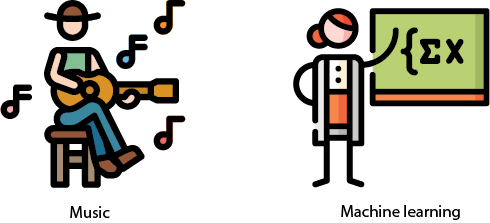
Figure FM.1 Music is not only about scales and notes. There is a melody behind all the technicalities. In the same way, machine learning is not only about formulas and code. There is also a melody, and in this book, we sing it.
With this in mind, I embarked on a journey to understand the melody of machine learning. I stared at formulas and code for months. I drew many diagrams. I scribbled drawings on napkins and showed them to my family, friends, and colleagues. I trained models on small and large datasets. I experimented. After a while, I started listening to the melody of machine learning. All of a sudden, some very pretty pictures started forming in my mind. I started writing stories that go along with all the machine learning concepts. Melodies, pictures, storiesthat is how I enjoy learning any topic, and it is those melodies, those pictures, and those stories that I share with you in this book. My goal is to make machine learning fully understandable to every human, and this book is a step in that journeya step that Im happy you are taking with me!

